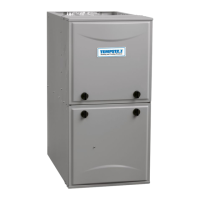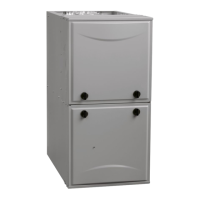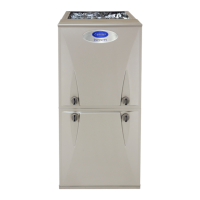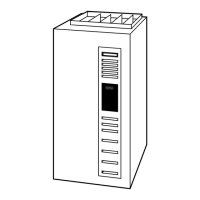F80CTL and G80CTL: Installation, Start–Up, Operating and Service and Maintenance Instructions
Manufacturer reserves the right to change, at any time, specifications and designs without notice and without obligations.
25
Inspections before the sale and at the time of installation will determine
the acceptability of the chimney or the need for repair and/or (re)lining.
Refer to Fig. 33 to perform a chimney inspection. If the inspection of a
previously used tile-lined chimney:
a. Shows signs of vent gas condensation, the chimney should be
relined in accordance with local codes and the authority having
jurisdiction. The chimney should be relined with a listed metal
liner, Type-B vent, or a listed chimney adapter kit shall be used to
reduce condensation. If a condensate drain is required by local
code, refer to the NFPA 54/ANSI Z223.1, Section 12.10 for
additional information on condensate drains.
b. Indicates the chimney exceeds the maximum permissible size in
the tables, the chimney should be rebuilt or relined to conform to
the requirements of the equipment being installed and the
authority having jurisdiction.
A chimney without a clay tile liner, which is otherwise in good
condition, shall be rebuilt to conform to ANSI/NFPA 211 or be lined
with a UL listed metal liner or UL listed Type-B vent. Relining with a
listed metal liner or Type-B vent is considered to be a vent-in-a-chase.
If a metal liner or Type-B vent is used to line a chimney, no other
appliance shall be vented into the annular space between the chimney
and the metal liner.
EXTERIOR MASONRY CHIMNEY FAN + NAT
INSTALLATIONS WITH TYPE-B DOUBLE-WALL
VENT CONNECTORS
E
NFPA & AGA
Appliance Application Requirements
Appliance operation has a significant impact on the performance of the
venting system. If the appliances are sized, installed, adjusted, and
operated properly, the venting system and/or the appliances should not
suffer from condensation and corrosion. The venting system and all
appliances shall be installed in accordance with applicable listings,
standards, and codes.
The furnace should be sized to provide 100 percent of the design heating
load requirement plus any margin that occurs because of furnace model
size capacity increments. Heating load estimates can be made using
approved methods available from Air Conditioning Contractors of
America (Manual J); American Society of Heating, Refrigerating, and
Air-Conditioning Engineers; or other approved engineering methods.
Excessive oversizing of the furnace could cause the furnace and/or vent
to fail prematurely.
When a metal vent or metal liner is used, the vent must be in good
condition and be installed in accordance with the vent manufacturer’s
instructions.
To prevent condensation in the furnace and vent system, the following
precautions must be observed:
1. The return-air temperature must be at least 60°F db except for brief
periods of time during warm-up from setback at no lower than 55°F
(13°C) db or during initial start-up from a standby condition.
2. Adjust the gas input rate per the installation instructions. Low gas
input rate causes low vent gas temperatures, causing condensation
and corrosion in the furnace and/or venting system. Derating is
permitted only for altitudes above 2000 Ft. (610 M).
3. Adjust the air temperature rise to the midpoint of the rise range or
slightly above. Low air temperature rise can cause low vent gas
temperature and potential for condensation problems.
4. Set the thermostat heat anticipator or cycle rate to reduce short
cycling.
Air for combustion must not be contaminated by halogen compounds
which include chlorides, fluorides, bromides, and iodides. These
compounds are found in many common home products such as
detergent, paint, glue, aerosol spray, bleach, cleaning solvent, salt, and
air freshener, and can cause corrosion of furnaces and vents. Avoid using
Table 7 – Minimum Allowable Input Rating of
Space-Heating Appliance in Thousands of Btuh per Hour
VENT HEIGHT
FT. (M)
INTERNAL AREA OF CHIMNEY
SQ. IN. (SQ. MM)
12
(7741)
19
(12258)
28
18064)
38
(24516)
Local 99% Winter Design Temperature: 17 to 26 degrees F
*
*. The 99.6% heating (db) temperatures found in the 1997 or 2001 ASHRAE
Fundamentals Handbook, Climatic Design Information chapter, Table 1A
(United States) and 2A (Canada) or the 2005 ASHRAE Fundamentals
handbook, Climatic Design Information chapter, and the CD-ROM included
with the 2005 ASHRAE Fundamentals Handbook.
6 0 55 99 141
8 52 74 111 154
10 NR 90 125 169
15 NR NR 167 212
20 NR NR 212 258
30 NR NR NR 362
Local 99% Winter Design Temperature: 5 to 16 degrees F
*
6 NR 78 121 166
8 NR 94 135 182
10 NR 111 149 198
15 NR NR 193 247
20 NR NR NR 293
30 NR NR NR 377
Local 99% Winter Design Temperature: -10 to 4 degrees F
*
6 NR NR 145 196
8 NR NR 159 213
10 NR NR 175 231
15 NR NR NR 283
20 NR NR NR 333
30 NR NR NR NR
Local 99% Winter Design Temperature: -11 degrees F or
lower
Not recommended for any vent configuration.
Table 8 – Combined Appliance Maximum Input Rating
in Thousands of Btuh per Hour
VENT HEIGHT
FT (M)
INTERNAL AREA OF CHIMNEY
SQ. IN. (SQ. MM)
12
(7741)
19
(12258)
28
(18064)
38
(24516)
6 (1.8) 74 119 178 257
8 (2.4) 80 130 193 279
10 (3.0) 84 138 207 299
15 (4.5) NR 152 233 334
20 (6.0) NR NR 250 368
30 (9.1) NR NR NR 404
CAUTION
!
BURN HAZARD
Failure to follow this caution may result in personal injury.
Hot vent pipe is within reach of small children when installed in
downflow position.
See the following instruction.

